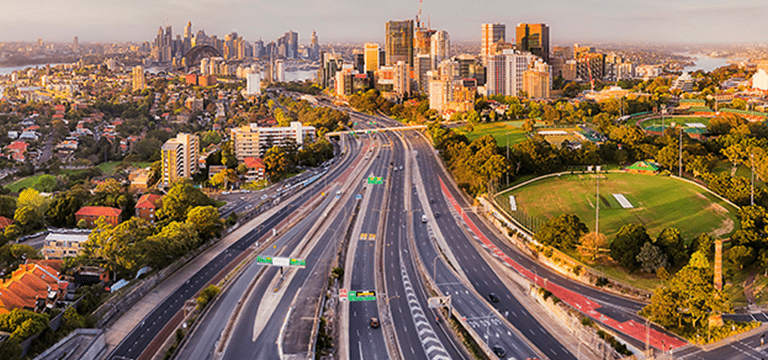

Australia


Resources & Infrastructure
Nestled between the vast expanse of the Pacific and Indian Oceans, Australia is not only renowned for its breathtaking landscapes but also for the abundance of its natural resources. The country’s rich resources and robust infrastructure have been a cornerstone of its economic prowess. From the vast mining operations that unearth precious minerals to the sophisticated infrastructure networks connecting cities and regions, Australia’s resources and infrastructure are integral to its status as an economic powerhouse.
Mining and Minerals
Australia is globally celebrated for its mineral wealth and is home to many valuable resources. The mining sector is pivotal in the nation’s economy, contributing significantly to export earnings and employment. Iron ore, coal, gold, copper, and natural gas are key minerals extracted.
Iron Ore
Australia is the world’s leading exporter of iron ore, a crucial ingredient in steel production. The Pilbara region in Western Australia hosts significant iron ore mines, such as Rio Tinto and BHP operations. Iron ore exports contribute significantly to Australia’s trade balance, creating economic stability.
Coal
Australia possesses extensive coal reserves, making it one of the top coal exporters globally. Australia’s economic resilience is increased by coal exports, which power businesses across the globe.
Gold and Copper
Australia consistently ranks among the top gold-producing nations, with mines like Super Pit in Western Australia. Prominent copper mines, such as the Olympic Dam in South Australia, bolster Australia’s mineral wealth.
Natural Gas
Australia is a major liquefied natural gas (LNG) exporter, with extensive projects in Queensland and Western Australia. Its natural gas exports bolstered Australia’s economic growth and worldwide energy prominence.
Infrastructure Transportation
- Roads and Highways: Australia boasts an extensive network of roads and highways connecting cities and remote regions.
- Rail Networks: Robust rail infrastructure facilitates efficient transportation of goods, mainly from mining regions.
Ports
Gateway to the World: Major ports like Port Hedland and Newcastle facilitate the export of minerals, supporting Australia’s global trade connections.
Energy Infrastructure
- Power Generation: Australia’s energy infrastructure includes a mix of coal, natural gas, and renewable sources, ensuring a stable power supply.
- Renewable Investments: Ongoing investments in renewable energy infrastructure showcase Australia’s commitment to sustainability.
Telecommunications
High-Tech Connectivity: Australia’s telecommunications infrastructure provides advanced connectivity, supporting business operations and innovation.
Economic Impact
The symbiotic relationship between Australia’s resources and infrastructure profoundly impacts its economy. The mining sector contributes significantly to export earnings, job creation, and economic stability. The revenue generated from resource exports and robust infrastructure support the country’s overall economic growth. Furthermore, the strategic infrastructure developments ensure efficient transportation of resources, enhancing Australia’s competitiveness in the global market.
In conclusion, Australia’s abundant resources, particularly in the mining sector, coupled with a well-developed infrastructure, form the backbone of the nation’s economic strength. This synergy propels Australia to the forefront of global resource markets and ensures sustained economic growth and resilience. The resources and infrastructure depict a nation harnessing its natural wealth to forge a prosperous and sustainable future.
Resources & Infrastructure
Nestled between the vast expanse of the Pacific and Indian Oceans, Australia is not only renowned for its breathtaking landscapes but also for the abundance of its natural resources. The country’s rich resources and robust infrastructure have been a cornerstone of its economic prowess. From the vast mining operations that unearth precious minerals to the sophisticated infrastructure networks connecting cities and regions, Australia’s resources and infrastructure are integral to its status as an economic powerhouse.
Mining and Minerals
Australia is globally celebrated for its mineral wealth and is home to many valuable resources. The mining sector is pivotal in the nation’s economy, contributing significantly to export earnings and employment. Iron ore, coal, gold, copper, and natural gas are key minerals extracted.
Iron Ore
Australia is the world’s leading exporter of iron ore, a crucial ingredient in steel production. The Pilbara region in Western Australia hosts significant iron ore mines, such as Rio Tinto and BHP operations. Iron ore exports contribute significantly to Australia’s trade balance, creating economic stability.
Coal
Australia possesses extensive coal reserves, making it one of the top coal exporters globally. Australia’s economic resilience is increased by coal exports, which power businesses across the globe.
Gold and Copper
Australia consistently ranks among the top gold-producing nations, with mines like Super Pit in Western Australia. Prominent copper mines, such as the Olympic Dam in South Australia, bolster Australia’s mineral wealth.
Natural Gas
Australia is a major liquefied natural gas (LNG) exporter, with extensive projects in Queensland and Western Australia. Its natural gas exports bolstered Australia’s economic growth and worldwide energy prominence.
Infrastructure Transportation
- Roads and Highways: Australia boasts an extensive network of roads and highways connecting cities and remote regions.
- Rail Networks: Robust rail infrastructure facilitates efficient transportation of goods, mainly from mining regions.
Ports
Gateway to the World: Major ports like Port Hedland and Newcastle facilitate the export of minerals, supporting Australia’s global trade connections.
Energy Infrastructure
- Power Generation: Australia’s energy infrastructure includes a mix of coal, natural gas, and renewable sources, ensuring a stable power supply.
- Renewable Investments: Ongoing investments in renewable energy infrastructure showcase Australia’s commitment to sustainability.
Telecommunications
High-Tech Connectivity: Australia’s telecommunications infrastructure provides advanced connectivity, supporting business operations and innovation.
Economic Impact
The symbiotic relationship between Australia’s resources and infrastructure profoundly impacts its economy. The mining sector contributes significantly to export earnings, job creation, and economic stability. The revenue generated from resource exports and robust infrastructure support the country’s overall economic growth. Furthermore, the strategic infrastructure developments ensure efficient transportation of resources, enhancing Australia’s competitiveness in the global market.
In conclusion, Australia’s abundant resources, particularly in the mining sector, coupled with a well-developed infrastructure, form the backbone of the nation’s economic strength. This synergy propels Australia to the forefront of global resource markets and ensures sustained economic growth and resilience. The resources and infrastructure depict a nation harnessing its natural wealth to forge a prosperous and sustainable future.
Australia



